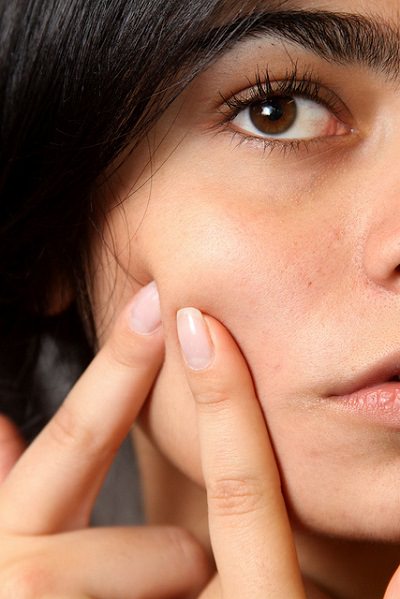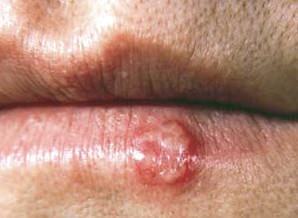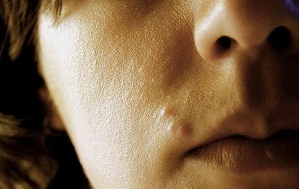
As tempting as it may be to pick at that unsightly zit on your face, skin-care experts agree that when it comes to bumps and blemishes, a hands off approach is your best bet. Popping a zit causes your skin to break apart, making it vulnerable to infection and permanent damage like scarring and broken blood vessels. So, keep your complexion fresh and flawless with these handy tips:

Ingrown Hairs

As frustrating as ingrown hairs may be, it is not worth picking at them. Ingrown hairs occur when the hair shaft becomes trapped beneath the skin's surface. The red bumps that follow tend to be itchy and inflamed, though using tweezers or manual force to pluck them out will break the skin, can lead to further inflammation and infection. At times, doing so may also lead to dangerous complications like a staph infection or sepsis (bacteria that can cause a multitude of diseases) further down the road.
Treat it: Apply hydrocortisone, which reduces redness, itchiness and irritation, and wash the affected area with an exfoliating cleanser, helping the hair reach the skin's surface.
Image: Source
Milia
Tiny white bumps are often known as milia. They appear on your face and refuse to pop no matter how hard you try. These bumps often appear to be hard, white cysts under the skin, so much so that picking at them has little to no effect. In fact, trying to pop milia will only leave your skin red, irritated and inflamed. The difference between this kind of pimple, compared to others, is that milia is not actually dirt, oil or grime, but trapped skin cells.
Treat it: Schedule an appointment with your dermatologist who will most likely extract it with a heated sterilized tool.
Keratosis Pilaris
Better known as chicken skin, this skin condition occurs as a build-up of the protein keratin (which protects the skin, hair and nails from infection and other harmful environmental toxins. The buildup forms a plug that blocks the opening of a hair follicle. Picking at the lesions can cause it to worsen and increase effects like redness and the potential for scarring as well.
Treat it: Use a chemical exfoliant that contains salicylic acid or glycolic acid, which will help calm inflammation down. If it doesn't go away, be sure to visit a dermatologist.

Touching these pesky bumps can cause them to spread, leading to the formation of another sore. Popping them also releases a blister-like fluid that contains the same virus, which can spread to other areas. As irritating as they may be, these blisters are caused by the herpes simplex virus which can be transmitted from one area of the body to another, through touching.
Treat it: Small sores generally heal over time with over-the-counter treatments. However, if you notice cold sores that are more frequent or spreading, seek professional treatment. Bear in mind that until the cold sore has become dormant, avoid kissing anyone, including your significant other.
Image Source
Cystic Acne
This type of pimple forms a red, tender nodule that is both painful and hard to treat. The inflammation that accompanies cystic acne can hinder the healing process, leading to permanent scarring that is difficult to eliminate.
Treat it: To treat the situation properly and eliminate scarring book an appointment with your dermatologist.
Blackheads
While blackheads are not as unsightly as red and inflamed spots, they can cause havoc on our complexion, especially when they colonize in pairs or groups. Just like whiteheads, blackheads are pores that become clogged with oil - except that the oil has oxidized after being exposed to the air, giving it a black or brownish hue. Squeezing blackheads forces the bacteria even deeper, causing trauma to the skin.
Treat it: Work the oil and dirt out of your face by using an exfoliating face wash.
Whiteheads

While whiteheads may seem pretty easy to pick at, when squeezed whiteheads release a mix of acne bacteria, oil and skin cells. Therefore a tiny pop can result in spreading that bacteria throughout your face. Picking at a whitehead also forces the bacteria deep into your skin and it can also transfer more bacteria from your fingers to your face.
Treat it: Allow the acne to clear on its own. Your body knows how to repair this damage by producing collagen - a substance that gives the skin support.
Image Source